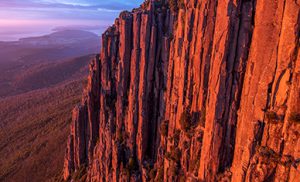Sustainable Buildings Forum

This jam packed 2 day event brought together leading practitioners in this field from around Tasmania as well as Australia and overseas.
At its western edge takayna/Tarkine is bounded by a windswept coastline and a wild ocean that not infrequently heaves up seas of eighteen metres and more. The rocky headlands and shifting dune fields found here hold the echoes of tens of thousands of years of indigenous living. Inland lie the rugged Meredith and Norfolk Ranges and beyond that spreads Australia’s largest temperate rainforest – 180,000 hectares of wild and verdant life.
Although nominated for World Heritage just 4% of takayna is protected as national park. The remainder is open to mining and rainforest logging.
And so in southern takayna Chinese state-owned mining company MMG intends to fill the McKimmie Ck valley – including almost 200ha of majestic, Masked Owl-filled rainforest, with a toxic waste dump. Other options for the mine waste exist but these would cost the company time and money.
15km to the west Venture Minerals has eyes and mining exploration licences over what they term their Province of Tin – the rainforested Mt Lindsay, Parsons Hood, and the remote and rugged Harman and Wilson valleys.
This is the jewel at the heart of takayna. Recent work by BBF has identified that the Wilson catchment holds the most extensive contiguous, intact and unlogged Huon pine forest that remains in Tasmania. Huon pines line these rivers and grow as pure stands on adjacent river flats for over 25km of wild river.
These are extraordinary, ancient trees – weathered by floods and time, twisted and gnarled. Through the centuries upper limbs have been colonised by mosses, lichens and ferns – and even other trees! Huon pines here that have been measured at close to 2m diameter are estimated to be 2500 years old. They are the second oldest discrete trees in the world, after the amazing Bristlecone pines.
And it’s even better than this. Groves of pines are thought in many cases to be not multiple trees, but a single or a few distinct beings only. Trees grow and fall, and roots swim into soil. From these roots and limbs other trees begin, and the process continues – indefinitely!
The multi-aged groves that Huon pines typically form may have lived and died and kept on living since the end of the last ice age, 10,000 years ago. Here is the mystery and lure of a tree that is, theoretically at least, immortal.
And into this slides Venture Minerals with Huon pine areas targeted for mines throughout the Wilson catchment and exploration tapes that cut right through a major stand of ancient trees in the middle reaches of the river. A faded yellow tape next to a 1000 year old pine identifies ‘Huon Habitat’ but the transect line is unperturbed.
